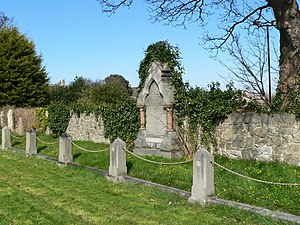Abergele train disaster

Abergele rail disaster memorial
|
|
| Date | 20 August 1868 |
|---|---|
| Location | Abergele, Conwy. |
| Country | Wales |
| Rail line | North Wales Coast Line |
| Cause | Runaway goods wagons |
| Statistics | |
| Trains | 2 |
| Deaths | 33 |
| List of UK rail accidents by year | |
The Abergele rail disaster, which took place near the town of Abergele, on the north coast of Wales in 1868, was, at the time, the worst railway disaster yet in Britain, and also the most alarming. The Railway News said of it:
"No other collision has ever yet, in this country at least, been attended with such a loss of life, nor presented such horrifying features. The crashing of the engine and carriages into a heap of splinters, each of which wounds unfortunate passengers like a sword, is horrible enough to contemplate; but when fire in its fiercest form is added to the scene, no more frightful occurrence could be imagined."
On 20 August 1868, at 7.30 a.m., the London and North Western Railway's down day Irish Mail train left the LNWR's London terminus Euston Station for Holyhead. One of the railway's most powerful engines Prince of Wales hauled behind it a chief guard's van, a travelling post office (mail van and tender), a luggage van, four passenger carriages, and a second guards van at the rear of the train. At 11.30 a.m. in Chester, four more passenger carriages were attached immediately behind the front guards van; the train then set off for Holyhead, its next scheduled stop, via the North Wales Coast Line (Chester and Holyhead Railway). At about 12.39 p.m the train passed through Abergele at about 40 miles per hour (~64 km/h). Following a late start from Euston and a further slight delay in Chester, it was about 5 minutes late overall; by that time, it should already have been 3 miles (5 km) further on and passing Llanddulas.
Ahead of it, a 'pick-up' goods train 43 wagons long had left Abergele at 12.15 p.m on the same line; to clear the down line for the express, the goods train was to be put into sidings at Llanddulas until the express had passed. At Llanddulas, there were two sidings (Llysfaen sidings), serving a lime quarry to the south of the line. When the goods train reached them (about 12.25 pm), both were partly occupied by goods wagons (‘cargo trucks’, or freight cars) and consequently neither siding could take the entire goods train. Under the direction of the Llanddulas stationmaster, therefore, the brake van and last six wagons of the goods train were uncoupled and left on the main down line (protected by the distant signal for Llanddulas). Rather than simply shunting the rest of the train into one of the sidings and returning for the odd six, a series of 'loose shunting' operations were embarked upon intended to put empty wagons (there were 26 in the train) into one of the sidings and accumulate a shorter train of loaded wagons on the main line ready to put into the other siding.
...
Wikipedia
